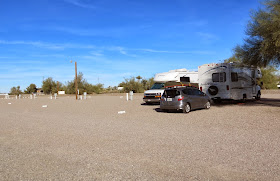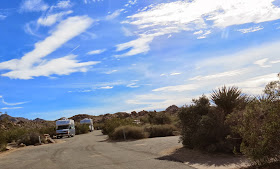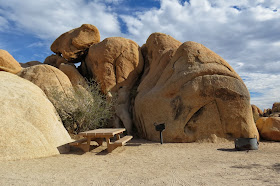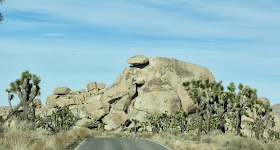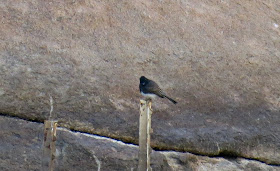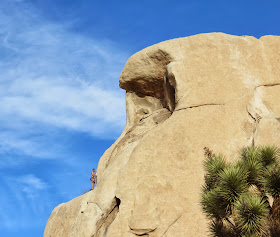Sunday, December 22, 2013
Moved to a new blog for 2014
Looking for Liz? I have started a new blog for 2014. Come join me in Baja! http://wheres-liz-2014.blogspot.com
Thursday, December 19, 2013
Quartzite and Joshua Tree National Park
Our visit to Quartzite, AZ was short, but now I have an idea what it is all about, and I can imagine what it is like in January when all the snowbirds have migrated here for the winter.
Our friend Sheila is here already, having staked out a site on BLM (Bureau of Land Management) land, where the living is very economical or free, depending on where you park. There are many gravel paths leading out into the desert and you can park anywhere you like.
Sheila pays a small amount for the season, and has water and dump privileges. There are no hookups here, so most everyone has solar panels and/or generators.
This is the view from Sheila's site. People who come here for the winter try to come back to the same site, although they cannot reserve it ahead of time...it is first-come, first-serve.
However, you can see where last year's tenants have landscaped with stones, marking "driveways" and borders. Newcomers pretty much respect other's marked "territories." It's not like there's a shortage of space to set up camp out here.
Some people are very creative and artistic with the rock landscaping. The scene will be very different in January, with thousands of RVers descending on Quartzite and the surrounding desert. Vendors will set up shop in town attracting even more bargain seekers to Quartzite.
Sheila was an excellent tour guide, negotiating all the various dirt paths. But when we reached this sign, we turned around. No one really wanted to encounter any nude sunbathers... We went out for dinner and had a nice visit instead.
After one night, Tina and I moved on to California's Joshua Tree National Park.
The view from my campsite.
This sign describes the park's two main ecosystems. Our campground is in the low, Colorado Desert, while the Joshua Trees grow in the higher Mojave Desert.
Off we go on our scenic drive through the park.
There are many side roads we left unexplored, like the ones to these old mines.
Lack of time, and lack of 4-wheel drive.
A vast expanse that is hard to capture in a photo.
We will cover some long distances to see the highlights.
We pass the Cholla Cactus Garden. Thistle has already learned the hard way about the cholla thorns.
They must have some recent transplants here, because the rangers are watering the cactus.
We have come to the place where the Colorado Desert meets the Mojave Desert. The change is gradual.
After a while we come to huge clumps of boulders, which soon dominate the landscape.
These massive rocks began underground eons ago as a result of volcanic activity.
Magma...in this case a molten form called monzogranite...rose from deep within the Earth, intruding the overlying rock.
The granite cooled and cracks formed. The granite continued its uplift and came in contact with ground water.
Weathering caused by the groundwater worked on the granite rocks, widening cracks and rounding corners.
Eventually the surface soil eroded, leaving heaps of rocks scattered across the land like careless piles of toy blocks.
And this is where the most popular campgrounds are located...in and amongst those piles of rocks.
And here is where we begin to see the Joshua Trees.
There are hiking trails out among the rocks that lead to special shapes and formations, like a rock arch, Skull Rock, etc.
The campsites here are best suited for small campers or tents, but there are a few that a big rig could squeeze into.
As you can imagine, people like to climb the rocks too.
This raven has a bird's eye view from atop a Joshua Tree.
More climbers.
A huge playground...
A group campground for tenters only.
Continuing on, we pass through a forest of Joshua Trees.
A trail leads to Hidden Valley, a legendary hideout of cattle rustlers. We passed that one by.
We took the road to Keys View, where from an elevation of 5,185 feet, we can overlook a stunning expanse of valley, mountain, and desert. That dark line in the valley is a section of the San Andreas Fault.
In this direction we can see the Salton Sea and across the border into Mexico.
Below on the right is the city of Palm Springs.
And in the distance, San Gorgonio Mountain, at 11,485 feet, is the tallest point in southern California.
There is a trail here where you can climb to an even higher viewpoint, but we thought we had a pretty good view already.
More rock shapes...
We stopped to take a hike to Barker Dam, originally built by ranchers to water their cattle.
Starting down the one-mile loop trail. Always bring water when hiking in the desert...even for a short hike.
Scenes from the trail...
The rain water that collects behind the dam attracts birds and other wildlife.
Contrasts...
In the background is the dam. Not much water here today, but if you look at the marks on the rocks, you can see how high it has been.
I only saw a couple of small birds.
The back side of the dam. The lower section of stone was the first dam, built in 1902. The Keys family added the upper concrete layer in 1949.
Below the dam is the cattle watering trough.
The cattle grazed on grasses in this natural basin below the dam.
Tina reads about the different plant life that exists here now.
This Pinon Tree was growing high in the rocks.
The return trail winds through Joshua Trees and other desert plants.
Indians that gravitated to the water left petroglyphs on the rocks.
Unfortunately someone painted over the originals, ruining their historical value.
Rocks where the petroglyphs were found.
Serious rock climbing takes place here too.
We went out of the park on the north side and drove through the town of 29 Palms before re-entering the park to return to the campground. I counted...there are more than 29 palms here.
A Sun Dog in the sky.
And back by the scenic vistas to our RVs. Joshua Tree National Park is worthy of another, longer visit.
But for now, we are on for our rendezvous at forum friend, Sharon's, where we will leave our cars during our trip to Baja. This will be my last post on this year's blog. Be looking for my new blog coming soon...Where's Liz? 2014.

